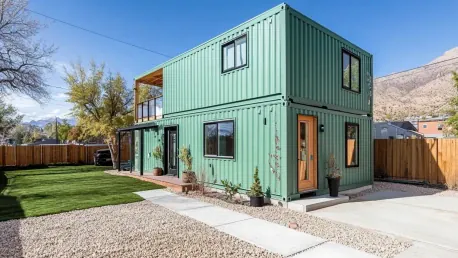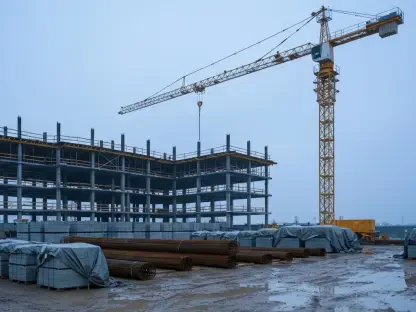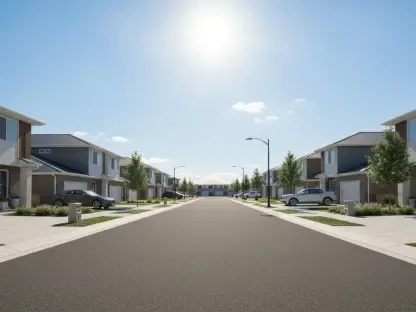The Ogden City Council is currently engaging in discussions about amending local ordinances to permit the use of shipping containers as residential accessory buildings. This initiative was introduced by Council Member Ken Richey, who highlighted the growing national trend of repurposing shipping containers for various residential uses. These uses range from tool sheds and workshops to small dwellings and recreational spaces, such as “man caves” or “she-sheds.” With a rise in innovative approaches to residential building, the city is at a crossroads regarding whether or not to embrace this unconventional but increasingly popular building method.
National Trend and Local Ordinances
The current ordinance in Ogden requires that shipping containers be surrounded by a more traditional structure. This regulation aims to maintain aesthetic continuity but has been criticized by Richey and other advocates as being overly restrictive. Senior Policy Analyst Steve Burton provided valuable context during the discussions by illustrating how other municipalities, including Weber County and Salt Lake City, are adapting their regulations to support the use of shipping containers. Compliance requirements such as applying siding to match the existing home, matching roofing aesthetics, and adhering to regulations on accessory structures, are becoming common practices in these areas.
The movement towards container-based structures also reflects a broader trend in sustainable building practices. Upcycling shipping containers not only reduces waste but also offers a cost-effective solution for adding extra space. As the prices for traditional building materials continue to rise, shipping containers present a budget-friendly alternative. Such structures have been embraced not only for their novelty but also for their practicality. However, adopting these methods requires careful consideration and systematic planning to ensure they meet the city’s building and safety standards.
Crucial Considerations and Regulatory Factors
Council Vice Chair Richard Hyer emphasized that any ordinance changes need to account for critical factors, including foundation requirements, square footage limits, permanence for setback requirements, height limits, roof design, and utility installations. Hyer believes that if the city moves forward with allowing shipping containers as accessory buildings, these structures should be subject to the same rigorous standards applied to traditional buildings. Questions remain about whether these containers could eventually serve as accessory dwelling units (ADUs), which introduces another layer of regulatory considerations.
The council’s discussions underscore the necessity of laying a robust foundation for these potential regulatory changes to avoid unintended consequences. A balanced approach is essential, incorporating both innovative and traditional building methods. Addressing these considerations adequately requires collaboration among various city departments, including planning, zoning, and building inspection. By bringing all stakeholders into the conversation, the city can develop a nuanced and comprehensive framework for integrating shipping containers into residential properties.
Examples and Support for the Initiative
Council Member Bart Blair offered his support for exploring the issue further by sharing his personal experience with a well-executed container home. Blair’s firsthand account highlights the potential benefits of allowing container structures when done thoughtfully and with a high standard of execution. His experience provides a practical example of how containers can be seamlessly integrated into residential contexts without compromising on aesthetics or functionality.
Blair’s endorsement showcases a growing acceptance among city officials that container homes are more than a fleeting trend—they represent a viable solution to housing challenges such as high construction costs and limited space. Furthermore, the council recognizes the importance of thorough discussions and consultations with experts and constituents to ensure that the introduction of container buildings aligns with the city’s broader strategic and environmental goals.
Next Steps and Future Considerations
The next steps involve planning officials returning with a detailed implementation plan for the ordinance change. This plan will likely address every issue raised during council discussions, including the nuances of siding, roofing, utility setups, and adherence to current building codes. Additionally, public consultations may be conducted to gather the opinions of residents and stakeholders on whether this change would be beneficial to the community.
The conversation during the work session was informative, though no immediate actions were taken. The council appears unified in its belief that adopting container structures into the city’s residential landscape holds potential. Still, the path forward must be paved with careful planning and rigorous adherence to safety and building standards. This thoughtful approach will ensure that if shipping containers become an accepted part of Ogden’s residential building practice, they will do so in a way that enriches the community and meets the needs of its residents.
Reflecting on the Future of Residential Building
The Ogden City Council is currently discussing possible changes to local regulations to allow the use of shipping containers as residential accessory structures. Council Member Ken Richey, who brought this proposal forward, pointed out the growing trend across the nation of repurposing these containers for residential purposes. These repurposed shipping containers have been used in various ways, including as tool sheds, workshops, small living spaces, and recreational areas like “man caves” and “she-sheds.” The city now faces a decision on whether to adopt this innovative yet unconventional building method that is becoming increasingly popular. As cities increasingly look for creative solutions to housing and space issues, Ogden is considering how to effectively integrate these versatile and modern structures into the community. This decision could have a significant impact on the city’s residential landscape, paving the way for more flexible and inventive uses of space.









